ISSN ONLINE(2319-8753)PRINT(2347-6710)
ISSN ONLINE(2319-8753)PRINT(2347-6710)
Yadhu G1, Raghunathan Rajesh 2
|
| Related article at Pubmed, Scholar Google |
Visit for more related articles at International Journal of Innovative Research in Science, Engineering and Technology
Manual material handling activities are an inherent part of any manufacturing plant, and causes significant musculoskeletal disorders of lower back, shoulders and lower extremities. A field study of a warehouse of a food processing company in the state of Kerala in India is undertaken to ascertain the ergonomic issues faced by workforce. This study aims at suggesting some ergonomic interventions that will reduce the risk of work related musculoskeletal disorders (WMSD) of warehouse operations. The ergonomic study of the warehouse revealed that the material handlers are subjected to awkward postures, and they use unscientific handling methods. Most of them are under medium to very high risk of WMSD. The ergonomic analysis reveals that there is an immediate need of implementing ergonomic interventions with proper awareness and training among workers. Quantitative analysis of the ergonomic interventions by digital human modelling and simulation (DHMS) are done using CATIA V5 software. It helps to regenerate the environment without affecting daily work in the work area. Some of those interventions include introduction of height adjustable pallet trucks and trolleys, ensure smooth material flow through new warehouse aisle layout, redesigning material handling equipments for better grip and safety. The ergonomic redesign of work system would mitigate issues of high physical exertion, WMSD and low productivity. Scope for further work includes quantification of ergonomic interventions benefits after a period of 3 years after implementation.
Keywords |
| Manual material handling, Work related musculoskeletal disorders, Ergonomics, CATIA, Digital human modelling and simulation. |
INTRODUCTION |
| Warehouses are a key aspect and critical hub of modern supply chains. Material handling (MH) is an important activity in warehouse operations and it cannot be avoided in logistics. There is a scope for reducing labour and enhancing productivity by emerging technologies in MH [1]. Manual material handling (MMH) is a labour intensive work which involves repetitive and demanding working conditions. Unscientific MMH can be the prime reason for WMSD [2]. It is now generally acknowledged among industrially advanced countries that WMSD affect employees in most industries and occupations, and these injuries impose heavy costs on employers and society such as low back pain. This need is more apparent in industrially developing countries due to the low level of automation and poor work organization. This study is the continuation of a previous study “Ergonomic study of a warehouse in a food processing industry” in Kerala using MH Check sheet, Nordic questionnaires and REBA analysis. The objective of this study is to suggest various ergonomic interventions and quantitatively assessing some of them using digital human modelling with the aid of CATIAV5. |
LITERATURE REVIEW |
| Ergonomics: Ergonomics is study of the relation between people and their work environment. An ergonomic approach for the design of industrial workstations attempts to (i) achieve an appropriate balance between the worker‟s capabilities and worker‟s requirements and (ii) provide the worker with physical and mental wellbeing, job satisfaction and safety. The ergonomic benefits include increased savings though lowering of injuries and worker compensation claims, increased productivity, increased morale and job satisfaction, and reduced absenteeism. |
| Work related musculoskeletal disorders: Warehouse workers constitute an occupational group who perform a lot of strenuous material handling and are prone to WMSD. The risk of developing back problems was 1.27 times higher for warehouse workers [3]. The most recent survey of self-reported work-related illness estimated that 1.1 million people in U.K suffered from WMSD caused or made worse by their current or past work. An estimated 12.3 million working days were lost due to these WMSD. The different losses due to WMSD can be summarized as loss of productivity, man days lost, training costs of new workers and compensation costs. Heavy manual labour, awkward postures, manual materials handling, and previous or existing injury are all risk factors implicated in the development of WMSD [1]. |
| Ergonomic interventions: Ergonomic interventions can be classified into three. They are engineering, administrative and behavioural interventions. Engineering interventions are engineered or physical manipulations of hazards or routes of exposure to physical hazards. Typical example is adjustable office equipment. Administrative interventions concentrate on changing the duties or the design of the job such as the introduction of job rotation, or for example requiring at least two persons to lift patients in a hospital. Behavioural interventions focus on the individual worker‟s behaviour or capacity. A behavioural (or personal) intervention may focus on increasing fitness or strength, on stress reduction workshops, on improving work methods. Among the three approaches engineering intervention attempts to remove the root cause of the stress and hence would derive the maximum benefit. Digital human modelling is among the best known design approach used to assess a given worksystem for effective engineering intervention, and is explained in the next section. |
| Digital human modelling and simulation: Digital Human Modelling and Simulation (DHMS) can be used to build models for production systems where abilities of the operators are related to the task requirements. Simulation can be used as a problem solving tool for creating an artificial history of the system, analyzing its behaviour, choosing correctly, understanding why, diagnosing problems and exploring possibilities [4]. Moreover DHMS aims at capturing experts‟ knowledge in different areas including anthropometry, mechanical work capacity, human kinematics and kinetics, work physiology, visual process and motion control. When integrated with Virtual Environments, DHMS facilitates the virtual evaluation of workstations layout, workflow simulation, assembly accessibility, human reach, clearance and strength capability studies and safety analysis [4]. Jack, Safework, 3D SSP and CATIA are the commonly used tools for DHMS |
METHODOLOGY |
| The study is focused on material handling operations of the material handlers (6 men and 7 women) working in a warehouse of a food processing company in Kerala and the Company is having its own distribution network across the state. All of them were informed orally about the objective of the study. It also employs one senior supervisor, 2 supervisors and 3 data entry operators in the warehouse. Finished goods from the nearby production facility are stored for delivery as per the order from the sales department. Common material handling operations are head loading and carrying a plastic sack weighing 25 kg from the storage area to the transport vehicle .Material handling equipments like trolleys and pallet trucks are also used to carry heavy loads. Sack consists of packed spice powders and rice based products clustered in small packing units. Usually 1 or 2 people are engaged in this work. They also handle carton boxes. Storage area consists of 40×28 m². There is also a loading and unloading bay in front of the storage area consists of 40×3 m². It also has an overhead storage space. Materials are stored on pallets. All the operations were observed randomly for a period of 30 days during the study. Material handling check sheet was used for recording all material handling details and problems related to day to day operations. All the material handing operations lifting, carrying, pushing, pulling etc. were video recorded or photographed. It was found that there was a considerable involvement of manual element in every stage of warehouse material handling. The findings of material handling check sheet, REBA analysis and NQ can be found in (Yadhu and Rajesh, 2014). The study methodology is shown in Fig 1. It is summarized below. |
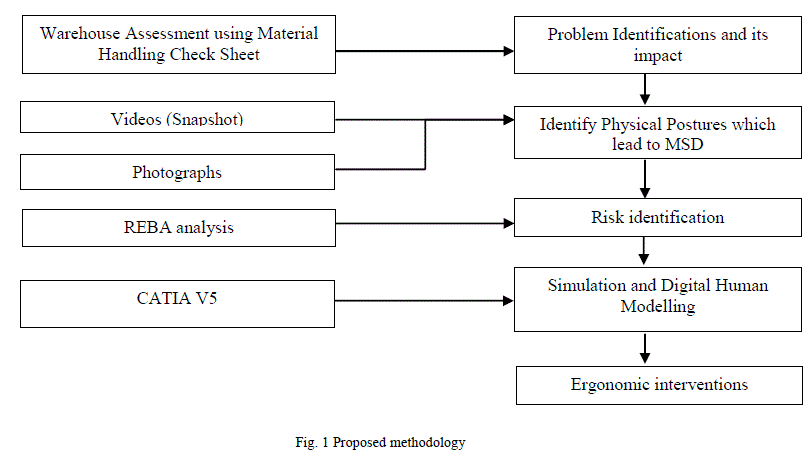 |
| After careful filtering of the photographs or video frames „REBA‟ was used on 8 common working postures to evaluate the ergonomic risk of the job or task. The results of REBA analysis are given in the Table 1. Based on literature survey and ergonomic study of the worksystem characteristics the primary risk factors are identified. They are „force‟, „posture‟, „time‟ and „personal characteristics‟. Some ergonomic interventions that will reduce the risk of WMSD were suggested. The findings were discussed with the material handlers and supervisors. Based on internal brain-storming the recommendations/interventions were narrowed in the Table 2. Some of the interventions are quantitatively assed by digital human modelling and simulation using CATIA V5 software. |
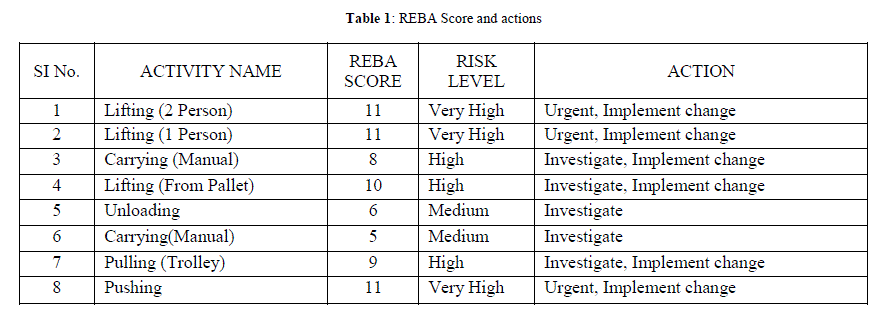 |
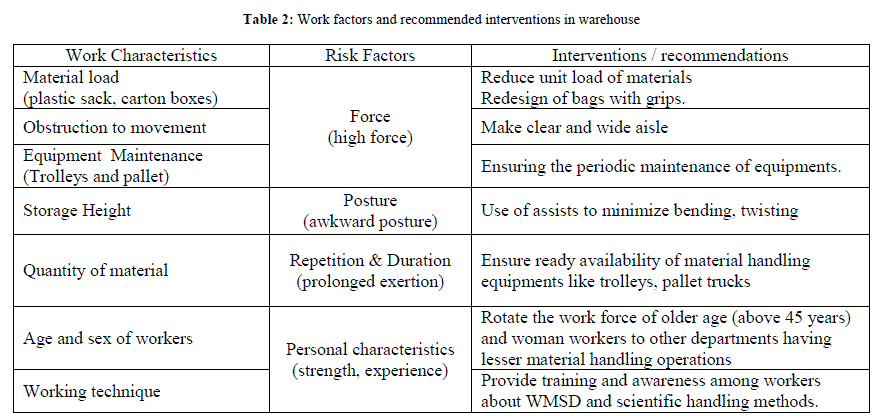 |
INTERVENTIONS |
| 4.1 Case 1 |
| Activity description: Material handling of the unit load weighing 15 kg is shifted from pallet truck to the vehicle. They were following an awkward posture for the material transfer, as the lifting is from the pallet which demands an intensive bending much below the recommended standard waist level. So the lifting activity involves all the body parts. Bending or twisting of the body is an unstable movement and is also observed in this task. Bending and twisting of the body is one of the major sources of back injuries, and neck and shoulder disorders. |
| Analysis & solutions: REBA posture analysis is done to assess the risk level and it is found that the person is in high risk category with a REBA score of 11 which needs immediate corrective action. The model inputs included anthropometry and work posture. A human mannequin model was built in CATIA software and a biomechanical analysis was done. |
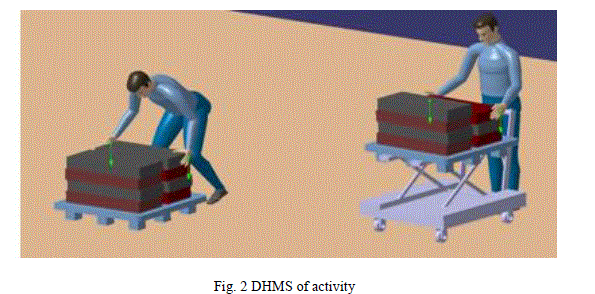 |
| The lower back compressive force for the task was 4765 N. The analysis revealed that the NIOSH biomechanical safe limit of 3400 N compressive force was exceeded and is therefore a risk for the development of lower back MSD. The suggested remedial action is the introduction of hydraulic operated height adjustable trolleys and pallet trucks. Both the situations were modelled using CATIA v5 are given in Fig. 2. The result of digital human modelling after intervention is satisfactory as the lower back compressive force for the task was 2999 N. Comparative results before and after intervention is given in Fig. 3. So many models of these trolleys and pallets are available in the market. Two of them are given in Fig. 4 (Source: WONT India Industrial equipments catalogue) with a capacity of 1000kg. |
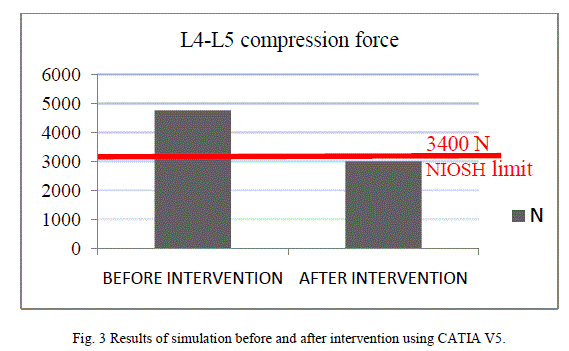 |
| 4.2 Case -2 |
| Activity Description: Material handling of the unit load weighing 25 kg is shifted from storage area to the vehicle with a distance travelled of 4-6 meters. Currently they are handling a weight of 25 kg. It contains packed processed spices ranging from 100 grams to 500 grams. They were following an awkward posture for the material transfer, as the lifting is from the pallet which demands an intensive bending much below the recommended standard waist level and sometimes above the shoulder level. Two photos of the activities are given in the Fig. 5. |
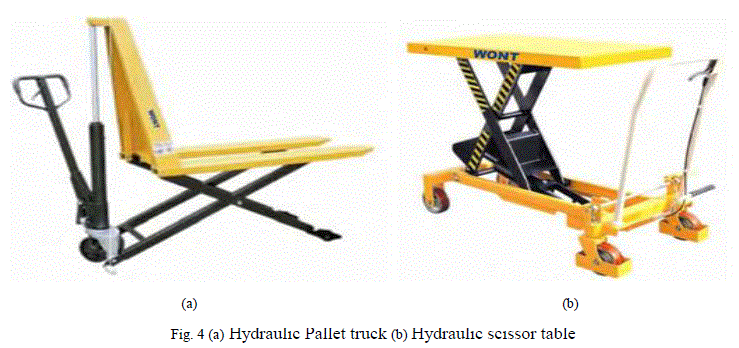 |
| Analysis & solutions: REBA posture analysis is also done to assess the risk level and it is found that the person is in high risk category with a REBA score of 11 which needs immediate corrective action. Intervention is based on the Guidance on the management of material handling in workplace by Health safety authority, Dublin, 2005. Interventions include |
| 1. The timely use of material handling equipments like trolleys and pallet trucks. Supervisors should ensure the ready availability of MH equipments. |
| 2. Avoid overloading when MH equipments are used. |
| 3. Lift smoothly without jerk and twist of body. |
| 4. Encourage assistance for lifting. |
| 5. Proper training should be given to workforce about safe lifting practices and the possible causes of WMSD. |
| 4.3 Case 3 |
| Activity description: Material handling of the unit load weighing 15 kg with dimensions 1m×0.5 m×0.4 m is shifted from pallet truck to the vehicle. Material handling of the unit load weighing 25 kg with dimensions 1.2 m×0.7 m×0.5m is shifted from storage area to the vehicle with a distance travelled of 4-6 meters. In both the cases it is observed that there is a lack of proper grip. Hence the workforce has to exert greater force to hold and carry these bags without slippage. Lifting bags which are non rigid and sags in the middle are considered as poor design. A good coupling is defined as a comfortable grip in which the hand can be easily wrapped around the object. |
| Analysis & solutions: Research findings indicate that working with loads with handles is safer and less stressful than working with the same kinds of loads without handles Drury, 1980; Garg and Saxena [8]. Ciriello et al. [8] reported that the maximum acceptable weights were about 16% lower when no handles were used. Rigby [8] showed that containers fitted with handles were less likely to be dropped. Drury [8] stated that handholds reduce oxygen consumption in a lifting task by 11% and could increase the exerted forces by up to 20% as compared to no handholds or handles. |
| The design guidelines [8] that are relevant for this case include |
| Place handles on containers so as to allow the load to be carried with both hands rather than one with maximum surface area. |
| Eliminate sharp corners, edges and finger grooves. |
| Make knurled or textured handles to prevent slippage. |
| The structure of the handle area should be stable, solid and durable in order to withstand MMH. |
| Handles must not be an obstacle and should not interfere with stacking the bags. |
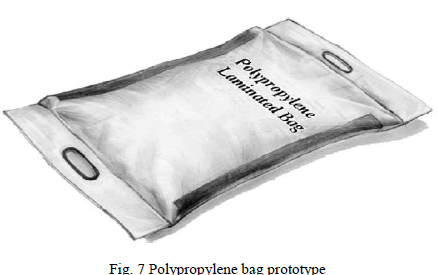 |
| Based on the design guidelines a polypropylene based bag is proposed Fig. 7.A polypropylene (PP) laminated bag with carrying handles will increase safety and decrease physical stress. Polypropylene laminated bags with carrying handles in which 2 rounded holes were punched at each end, and polyethylene rings, were then heated and applied around the holes to strengthen them. Carrying loads is much easier and quicker if they can be grasped easily and firmly. With good grips there is less chance of dropping the loads, and thus damage to materials is prevented. Good handholds reduce fatigue because less muscle power is required to hold the load. |
| 4.4 Case 4 |
| Some of the environmental factors which affect the smooth flow and force required for material movements are workspace floors, congestion and proper maintenance of MH equipments being used. Analysis of the material handling check sheet indicates that the loading and unloading bays in front of the warehouse are facing the problems like heavy cross traffic, material obstructions and unmarked aisles. This directly increases the force required for material movements and a lot of time is lost as non value added time. It is explained using Fig. 8. It is also observed that there is no separate aisle for continuous material movements. This creates the problems like heavy cross traffic and crowded workplace. This affects the productivity of material movement adversely. |
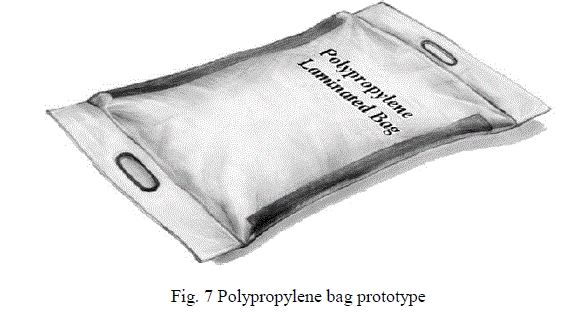 |
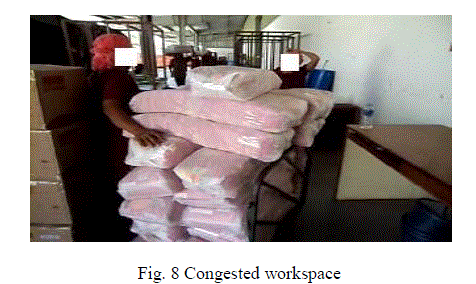 |
| A new layout of loading and unloading bay is suggested to overcome the current problems of unplanned material movements and is given in Fig. 9. It incorporates properly marked aisles for keeping the loaded and unloaded MH equipments like trolleys and SKU. There is also a no obstruction zone which ensures smooth flow of materials and reduces idle time. New layout proposes 3 different aisle zones which are marked using different colours .The green zone indicates the area to keep the unloaded trolleys and stock keeping units (SKU) cage .The red zone indicates no obstruction zone where supervisors should ensure the smooth flow of men and materials. The yellow zone indicates the area to keep the loaded trolleys and SKU cages. Random observation showed that there is a lack of maintenance in the MH equipments like trolleys which increases the force requirement for pulling and pushing as very small segments of bags (unit load) got struck between the wheels and fixing structure (nuts and bolts). So proper training and awareness among the workforce regarding periodic cleaning, lubrication, planned material movements and effective use of aisles should be created. |
CONCLUSION |
| All hazardous and stressful MMH tasks cannot be avoided since physical labour and MMH will continue to be an integral part of warehouse operations. These case study based ergonomic interventions from a human factors engineering point of reduce musculoskeletal, physiological and psychophysical stresses. Results ascertain that the suggested interventions will reduce the risk of WMSD and improve productivity if implemented systematically. The recommendations were discussed with the Supervisors and Plant manager, and it was well received. The scope for further works includes assessing the ergonomic, economic and productivity benefits of the suggested interventions. A study before and after ergonomic interventions considering the physiological responses like heart rate, blood pressure, oxygen consumption of the workforce will help to determine the effect of interventions. |
RECOMMENDATIONS |
| These case studies illustrate the urgent need of ergonomic interventions in the warehouse operations. This study provides evidence supporting recommendations for workstation ergonomic adjustments in order to improve work related posture and thereby reduce low back complaints among material handlers. Based on the evaluation results, ergonomic recommendations for the warehouse include |
| 1. Introduction of hydraulic operated height adjustable pallet trucks and forklifts. It reduces the compression force below the biomechanical design limit of 3400 N. |
| 2. Adequate training for MH operations to avoid activities like lifting above shoulder height which are the reasons for WMSD. |
| 3. New design of material handling bags with proper grip. |
| 4. New aisle layout for loading and unloading bay of the warehouse.` |
| The interventions provided through cases 1 and 2 reduces exposure to work-related risk factors associated with MSD as it reduces the strain on different body parts. Safety concerns enhanced the attractiveness of the proposed polypropylene bag with handles because it not only reduced risk factors associated with musculoskeletal disorders but also greatly decreased the chance of slippage. The new layout suggested increases the productivity of WH operations. It indirectly reduces the force required for material movement ensuring the smooth flow principle of WH operations. |
ACKNOWLEDGEMENT |
| The authors acknowledge the whole hearted effort put by the participating workers; support extended by the Human Resource Head and Production Head of the Food Processing Industry for the survey and observational study. We thank Central Library of NIT, Trichy and CUSAT for providing access to journal materials. |
References |
|